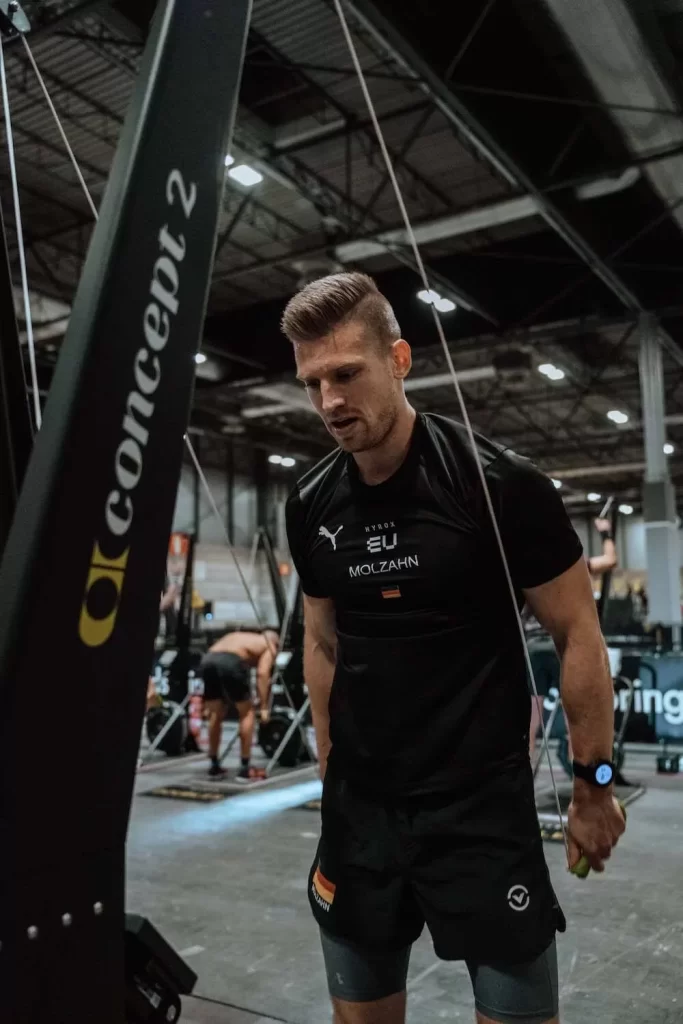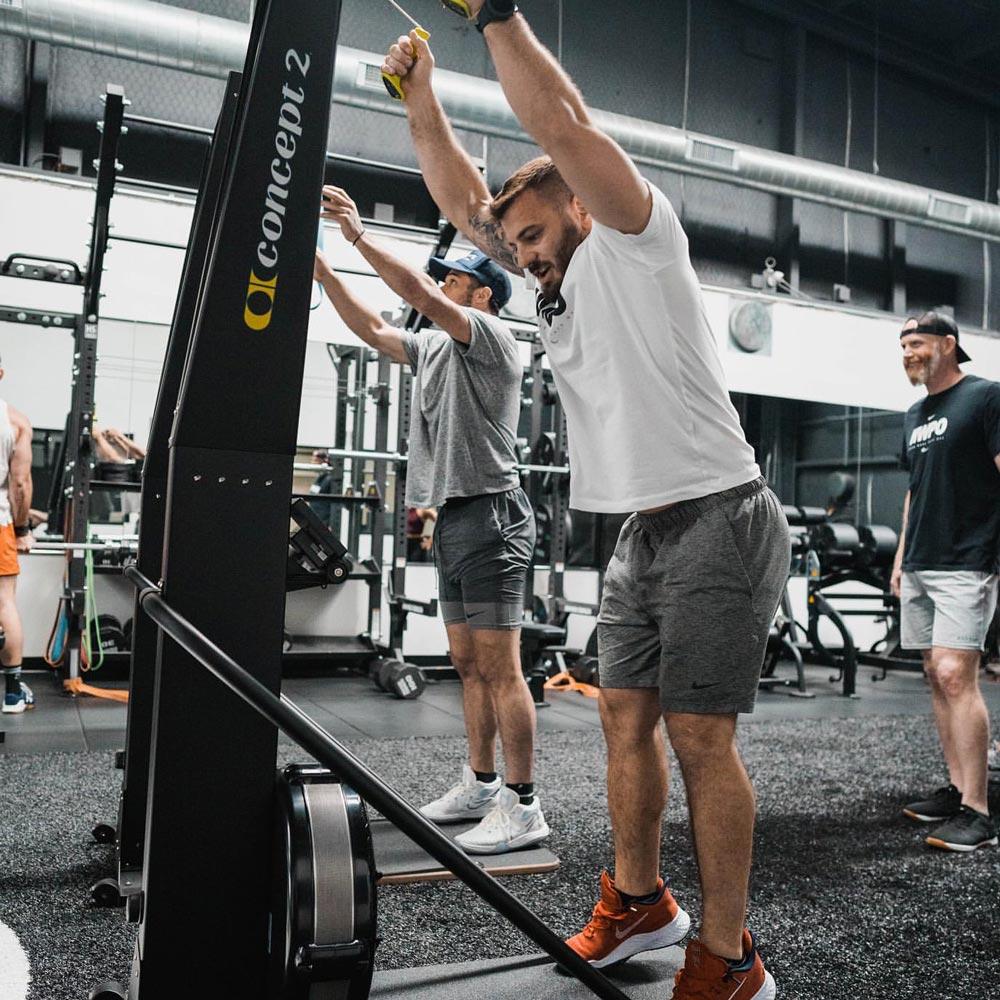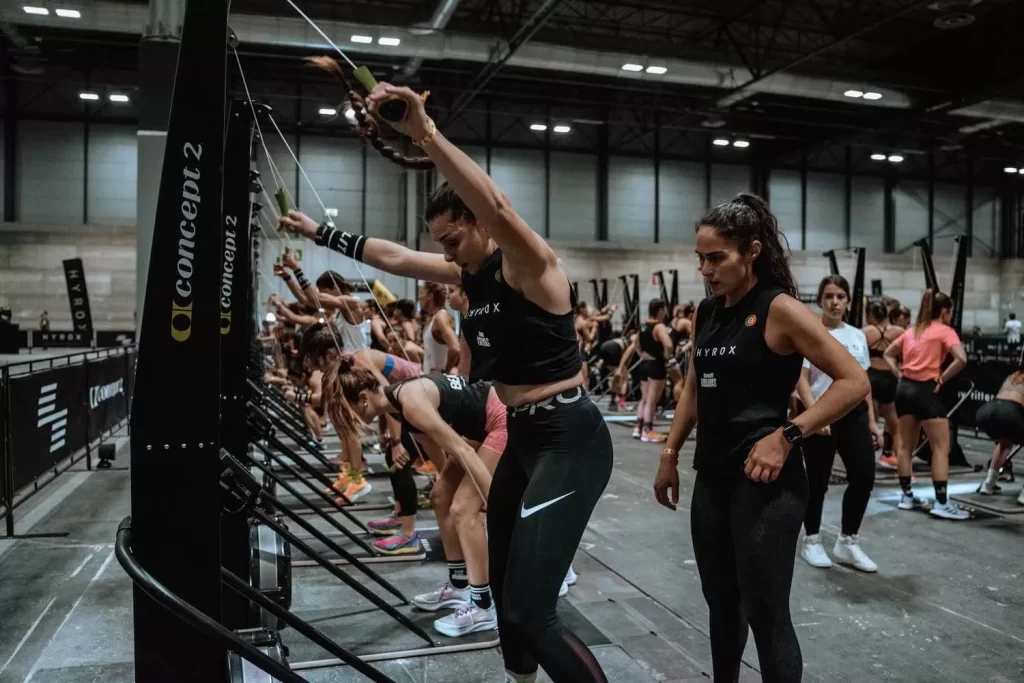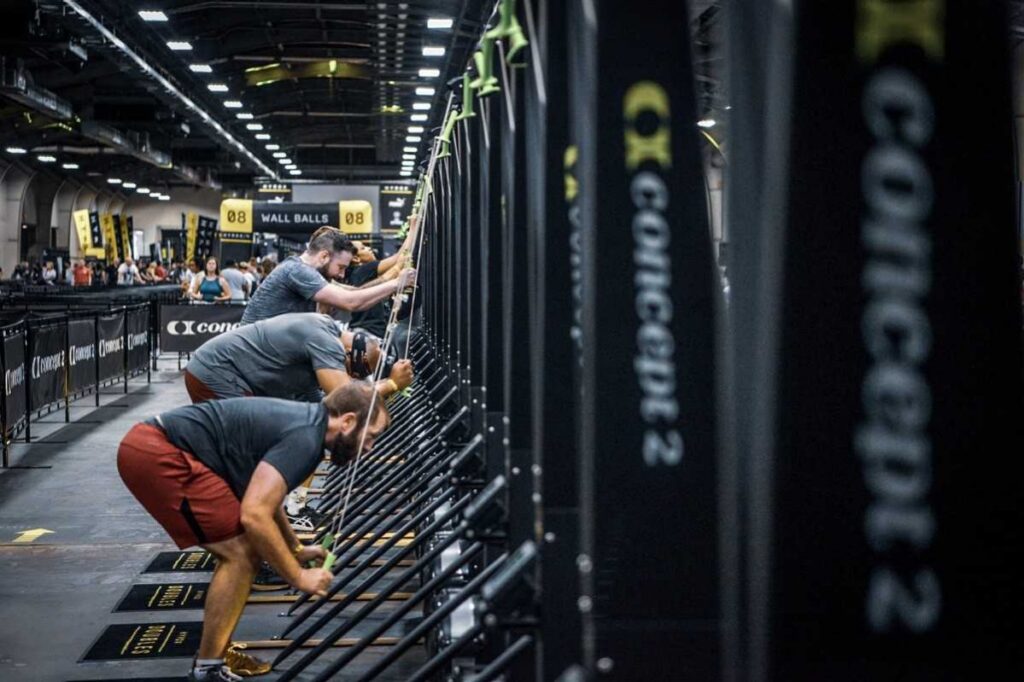Now, to continue our series of articles on tips and strategies to improve each HYROX station. Next up, it’s….. SkiErg.
Optimizing Your HYROX SkiErg Experience: Concept2 SkiErg Equipment and Preset Settings
In the dynamic world of HYROX events, the Concept2 SkiErg is the key equipment for a challenging 1000m (1km) skiing segment. To ensure a fair yet intense competition, the ergometer comes preset with specific resistance levels:
- Women: Resistance Level 5
- Men / Women Pro: Resistance Level 6
- Men Pro: Resistance Level 7
According to HYROX rules, athletes have the flexibility to adjust the resistance to their personal preference before the start. It’s a one-time choice, though, as alterations once the event commences are not permitted.

Section 1: Understanding the SkiErg in HYROX
The Dynamics of SkiErg: The SkiErg event in HYROX which is the station in a HYROX event introduces a unique challenge that combines cardiovascular endurance with full-body engagement. Participants simulate the motions of cross-country skiing by pulling on two handles connected to a flywheel. Understanding the intricacies of the SkiErg is fundamental for optimizing performance in this event.
The Ergometer Setup: The SkiErg is an ergometer, a device designed for indoor training that measures the work performed. It typically consists of two handles, a flywheel, and a performance monitor. The resistance is adjustable, allowing participants to tailor the intensity of their workout.
Full-Body Engagement: Unlike traditional skiing, the SkiErg engages the entire body, including the arms, core, and legs. The pulling motion activates the muscles in the back, shoulders, and arms, while the legs provide additional power through a controlled squatting movement.
Monitoring Performance Metrics: The performance monitor displays crucial metrics such as distance covered, time elapsed, and pace. Understanding how to interpret these metrics is vital for pacing, especially in the context of a multi-event competition like HYROX.
Adaptability to Different Fitness Levels: The SkiErg is adaptable to various fitness levels. Participants can control the intensity by adjusting the resistance and pacing themselves. This versatility makes it accessible to both elite athletes and those new to fitness competitions.
Integration into HYROX Sequences: In the HYROX competition, the SkiErg is often integrated into a sequence of exercises. Participants might transition from running to the SkiErg, demanding a quick shift in muscle engagement and energy systems. Mastery of the SkiErg involves not only efficient pulling but also strategic transitions.
Section 2: Techniques to Optimize SkiErg Performance

1. Efficient Grip and Hand Position:
- Neutral Wrist Alignment: Maintain a neutral wrist position while gripping the handles. Avoid excessive bending or hyperextension of the wrists, as this can lead to discomfort and reduce efficiency.
- Grip Variation: Experiment with grip variations to find what works best for you. Some athletes prefer an overhand grip, while others may find a mixed or underhand grip more comfortable. Choose a grip that allows for a natural and powerful pulling motion.
2. Proper Body Positioning:
- Engage Core Muscles: Initiate the pull with a strong engagement of your core muscles. This provides stability and ensures that the power generated from the pull is efficiently transferred to the flywheel.
- Straight Back: Maintain a straight and upright back throughout the movement. Avoid excessive leaning forward or backward, as this can compromise your posture and reduce the effectiveness of the pull.
3. Coordinated Arm and Leg Movement:
- Synchronized Motion: Coordinate the movement of your arms and legs for a fluid and efficient stroke. As you pull the handles towards you, initiate a controlled squatting motion with your legs. This combination of upper and lower body engagement mirrors the motions of actual skiing.
- Powerful Leg Drive: The legs play a significant role in generating power. Focus on driving through your legs during the squatting phase, using them as a powerful base for the pulling motion.
4. Breathing Technique:
- Rhythmic Breathing: Establish a rhythmic breathing pattern to support your cardiovascular endurance. Sync your breath with the pulling motion, exhaling as you pull the handles towards you and inhaling as you return to the starting position.
- Consistent Oxygen Flow: Efficient breathing ensures a steady flow of oxygen to your muscles, delaying the onset of fatigue and sustaining your performance over longer durations.
5. Pacing Strategies:
- Consistent Pace: Maintain a consistent pace throughout the SkiErg event. Avoid starting too fast and burning out early. Instead, find a sustainable pace that allows you to cover the required distance without compromising form.
- Strategic Intensity Adjustments: Take advantage of the SkiErg’s adjustable resistance. If you feel fatigued, consider lowering the resistance temporarily to maintain a steady pace. Conversely, increase the resistance for a more challenging workout when you’re feeling energized.
6. Dynamic Transitions:
- Practice Transitions: Since the SkiErg is often integrated into a sequence of exercises in HYROX, practice transitioning smoothly from other elements to the SkiErg. Develop a quick and efficient transition strategy to minimize downtime between exercises.
- Maintain Focus: During transitions, maintain mental focus on the upcoming SkiErg segment. Quickly switch your mindset from the previous exercise to the pulling motion of the SkiErg to ensure a seamless continuation of your performance.
In summary, optimizing SkiErg performance involves mastering the pulling technique, coordinating arm and leg movements, maintaining proper posture, implementing effective breathing, pacing strategically, and practicing dynamic transitions. These techniques collectively contribute to a more efficient and powerful SkiErg performance in the context of a multi-event competition like HYROX.
Section 3: Targeted Training to Enhance SkiErg Performance

1. Strength and Power Training:
- Leg Strength Exercises: Strengthening the muscles used in the squatting motion is essential. Include exercises such as squats, lunges, and leg presses in your strength training routine. These compound movements build the power needed for the leg drive during SkiErg pulls.
- Upper Body Strength: Focus on building upper body strength, particularly in the back, shoulders, and arms. Pull-ups, rows, and lat pulldowns are effective exercises to target these muscle groups. A strong upper body contributes to a powerful pull on the SkiErg handles.
2. Endurance-Based Workouts:
- Long-Distance SkiErg Sessions: Develop cardiovascular endurance with longer SkiErg sessions. Set a target distance or time and work on sustaining a steady pace. This type of training prepares you for the continuous effort required in HYROX.
- Interval Training: Incorporate interval training into your SkiErg workouts. Alternate between periods of high-intensity pulls and active recovery or lower-intensity pulls. This mimics the varied intensity of the SkiErg element in HYROX.
3. Technique-Specific Drills:
- Isolated Arm and Leg Movements: Practice isolated arm and leg movements on the SkiErg to fine-tune your coordination. This involves pulling with just the arms or just the legs to emphasize each component of the movement. Gradually integrate these into full strokes for improved synchronization.
- Focus on Efficiency: During training, pay specific attention to maintaining efficient form. Ensure that your movements are smooth, and power is transferred effectively from the legs to the arms. This focus on efficiency becomes crucial during the demands of a HYROX event.
4. Simulated HYROX Sequences:
- Combine SkiErg with Other Exercises: Create workout sequences that simulate the HYROX event structure. For example, perform a set of SkiErg pulls followed by a short run or another exercise. This type of training prepares your body for the demands of transitioning between different elements.
- Time-Based Challenges: Challenge yourself with time-based workouts that closely match HYROX timeframes. This type of training conditions you to sustain effort and intensity within the specific time constraints of the competition.
5. Mental Preparedness Strategies:
- Visualization Techniques: Practice visualizing successful SkiErg performances. Picture yourself smoothly gliding through each pull, maintaining form, and seamlessly transitioning to the next element. Visualization enhances mental preparedness and builds confidence.
- Focus on Process Goals: Instead of solely focusing on the outcome, set process-oriented goals during training. Concentrate on maintaining proper technique, coordinating movements effectively, and executing strategic transitions. Achieving these micro-goals contributes to overall success.
6. Recovery Practices:
- Active Recovery Sessions: Integrate active recovery sessions into your training routine. This could involve light cardio, mobility exercises, or even techniques like yoga. Active recovery supports muscle recovery and reduces the risk of overtraining.
- Hydration and Nutrition: Emphasize proper hydration and nutrition in your recovery routine. Replenish electrolytes, consume a balanced post-workout meal, and ensure you’re meeting your nutritional needs for optimal recovery.
By incorporating targeted training in strength, endurance, technique, simulated event sequences, mental preparedness, and recovery practices, you enhance your overall SkiErg performance. These strategies not only build physical capabilities but also prepare you for the specific challenges presented by the SkiErg element in HYROX.
Section 4: Fine-Tuning Your SkiErg Technique
1. Video Analysis for Form Evaluation:
- Record and Review: Utilize video recording to assess your SkiErg technique. Record yourself from different angles to evaluate aspects such as hand positioning, body posture, and the fluidity of your movements. This visual feedback is valuable for identifying areas that require refinement.
- Consult with Experts: Consider seeking feedback from fitness professionals or experienced SkiErg users. They can provide insights based on their expertise and might notice nuances in your technique that can be improved for greater efficiency.
2. Coach-Guided Sessions for Precision:
- Engage with a Coach: If possible, engage in coach-guided sessions. A coach can offer real-time feedback and corrections as you perform SkiErg pulls. This interactive approach is particularly beneficial for addressing subtle issues that may not be immediately apparent.
- Structured Coaching Programs: Explore structured coaching programs designed specifically for SkiErg training. These programs often include progressive workouts and detailed technique guidance to help you refine your skills over time.
3. Consistent Practice for Muscle Memory:
- Repetition for Mastery: Fine-tuning your SkiErg technique requires consistent and deliberate practice. Regularly include dedicated SkiErg sessions in your training routine to reinforce the correct movement patterns and develop muscle memory.
- Progressive Challenges: Gradually introduce challenges to your SkiErg practice. This could involve increasing resistance, adjusting the duration of your sessions, or incorporating interval variations. Progressive challenges prevent stagnation and contribute to ongoing improvement.
4. Efficiency in Energy Expenditure:
- Economical Motion: Strive for an economical pulling motion. Minimize unnecessary movements that don’t contribute to the generation of power. A streamlined technique not only conserves energy but also allows for sustained effort over longer durations.
- Balance Power Distribution: Ensure a balanced distribution of power between your arms and legs. The legs should initiate the movement, and the arms should follow through smoothly. This balance optimizes the efficiency of your SkiErg pulls.
5. Focus on Transition Techniques:
- Seamless Exercise Transitions: In HYROX, transitions between exercises are crucial. Practice transitioning from other elements to the SkiErg and vice versa. Focus on maintaining form and a steady pace during these transitions, as this contributes to overall efficiency.
- Quick Mental Shifts: Train your mind to make quick shifts between different elements. Develop a mental cue or ritual that signals the transition from one exercise to the SkiErg. This mental preparedness is valuable during the dynamic structure of a HYROX event.
6. Incorporate Skill-Building Drills:
- Isolated Technique Drills: Integrate isolated drills into your training sessions. This could involve drills that emphasize specific aspects of the SkiErg pull, such as the initial drive or the release phase. Isolated drills provide focused practice for honing individual components of your technique.
- Interval Technique Training: Implement interval training specifically focused on technique. Alternate between periods of concentrated technique work and regular SkiErg pulls. This targeted approach allows you to address specific aspects of your technique during training.
In summary, fine-tuning your SkiErg technique involves a comprehensive approach, including video analysis, coach-guided sessions, consistent practice, efficiency in energy expenditure, focus on transitions, and the incorporation of skill-building drills. These refinements collectively contribute to a more polished and effective SkiErg performance in the context of HYROX.
Section 5: Additional Tips for SkiErg Success

1. Strategic Handle Grips:
- Experiment with Grip Styles: Try different grip styles to find the one that maximizes your comfort and power. Some athletes prefer an overhand grip, while others may find a mixed or underhand grip more effective. The right grip minimizes fatigue and enhances control.
- Handle Height Adjustment: Many SkiErg machines allow for handle height adjustment. Experiment with different heights to determine the position that feels most natural and allows for a full range of motion during pulls.
2. Mental Resilience Strategies:
- Positive Affirmations: Cultivate a positive mindset. Use positive affirmations to boost your confidence before and during SkiErg sessions. Remind yourself of your progress, capabilities, and the hard work you’ve invested in your training.
- Focus on Micro-Goals: Break down your SkiErg performance into smaller, achievable goals. Instead of fixating on the total distance or time, concentrate on completing each pull with precision and maintaining consistent pacing. Achieving micro-goals builds confidence.
3. Equipment Familiarity:
- Regular Equipment Checks: If you have access to a personal SkiErg or consistently use the same machine, conduct regular equipment checks. Ensure that the resistance settings and overall functionality are optimal. Familiarity with your equipment minimizes surprises during workouts.
- Adapt to Different Machines: In HYROX, you might encounter different SkiErg models. Practice on various machines if possible to adapt to potential differences in feel and performance.
4. Breathing Techniques:
- Sync Breathing with Pulls: Refine your breathing techniques to sync with your SkiErg pulls. Coordinate your exhales with the pulling phase and inhales during the recovery phase. This rhythmic breathing enhances endurance and overall performance.
- Mindful Breathing during Transitions: Pay attention to your breath during transitions between exercises. Controlled breathing helps maintain composure and mental focus, essential during the dynamic nature of HYROX.
5. Pre-Event Preparation:
- Warm-Up Routine: Develop a comprehensive warm-up routine that specifically targets muscles involved in SkiErg pulls. A well-prepared body is more responsive, reducing the risk of injury and enhancing performance.
- Mental Visualization: Prior to a HYROX event, engage in mental visualization of the SkiErg segment. Imagine yourself executing flawless pulls, managing transitions smoothly, and maintaining a consistent pace. Visualization contributes to pre-event mental readiness.
6. Periodized Training Cycles:
- Structured Training Phases: Implement periodized training cycles leading up to a HYROX event. Designate specific phases for strength building, endurance training, and technique refinement. A structured approach optimizes your overall readiness for the demands of SkiErg and other elements in HYROX.
- Tapering for Peak Performance: In the weeks leading to the event, incorporate a tapering phase. Reduce training volume while maintaining intensity to ensure peak performance on the day of the competition.

In conclusion, success in the SkiErg event of HYROX involves a combination of physical preparation, mental resilience, familiarity with equipment, breathing techniques, pre-event preparation, and strategic training cycles. By integrating these additional tips into your overall SkiErg training strategy, you enhance your chances of performing at your best during the competition.
Congratulations on completing this comprehensive guide to mastering the SkiErg in the context of HYROX! Wishing you success in your fitness journey.
If you would like to read more of our articles on HYROX, please click the links below:
The Ultimate HYROX workout guide for wall balls
The Ultimate HYROX workout guide for wall balls
Hyrox: The Ultimate Deep Dive
